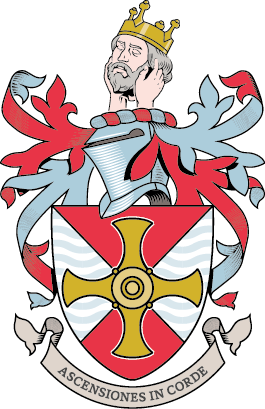
Archive #29/65: College Houses
Many Old Boys remember some healthy competition at House Competitions. The two original Houses were Aidan and Cuthbert, with Oswald and Durham established in the 1970s.

Durham House, established 1977
Durham Priory was associated with Durham Cathedral in the North-East of England. A community of Benedictine or Black Monks came to Durham on 28 May 1003 and lived and worshipped God in the priory for 456 years. They administered the shrine of St Cuthbert and cared for all the visitors and pilgrims.
Durham priory was a very busy place. It inherited a lot of land and further estate was gifted to it. The monks were good stewards of the property. They owned farms, granges, mills and parish churches and manors. Wherever the monks settled they brought wealth, security education and welfare.
At the end of the 15th century their building improvements were nearing completion and forty years later at the end of 1539 they surrendered their priory to Henry VIII. The crown confiscated as much of the priory’s wealth as it could and then re-founded the Priory as Durham Cathedral.
The youngest of the four Houses at Lindisfarne College, Durham House began as a dayboy House in 1977.

Oswald House, established 1974
King Oswald was born in 605, the son of a royal house.
He came to rule after spending a period of exile on the death of his father. While in exile he got to know the Irish monks on the island of Iona and was baptized under Iona’s influence. Later he asked the community at Iona for a monk to evangelise amongst the English in his kingdom. Iona sent him St Aidan. King Oswald died in battle in 642.
Begun as a dayboy House, Oswald House was named as the third of Lindisfarne College’s four Houses in 1974.

Cuthbert House, established 1953
St Cuthbert of Lindisfarne was born in 634 and died on 20 March 687.
Following the death of St Aidan he became an Anglo-Saxon monk. He spent many of his early years at Melrose undertaking long missionary journeys and possessed a genuine gift of healing. In 685 he agreed to leave his semi-reclusive life on the island of Farne and become Bishop of in the Kingdom of Northumbria. However in failing health he withdrew to his old retreat on the Farnes where he died two years later. Cuthbert’s body, originally kept at Lindisfarne was found some years later uncorrupted. Two centuries later when the island fell to the Danes the monks took the coffin and fled, carrying with them the beautiful manuscript known as the Lindisfarne Gospels. Their boat was shipwrecked of the Cumbrian coast but the book in its case was unharmed.
As with Aidan House, Cuthbert House was established in the first year of the College’s existence, 1953.

Aidan House, established 1953
Known as St Aidan of Lindisfarne, Aidan was born in Ireland and died in Northumberland on 31 August 651. Originally coming to the Holy Island as an Irish monk from Iona, Aidan was founder and first Bishop of the monastery on the island and slowly restored Christianity to the Northumbrian communities. He was a man of peace, love, humility and was above anger or greed. He tenderly comforted the sick and protected the poor.
To honour the Apostle of Northumbria, Aidan House was one of the two original Houses (with Cuthbert) established at Lindisfarne College in 1953, its founding year.
Article added: Friday 15 November 2019


